We slept in a bit due to our late arrival; heard the 5 a.m. call to prayer and turned over and went back to sleep. After breakfast, we went in search of a
dentist (Craig had a crown that fell out in Rome, which was fairly simply glued
back in place) and then took the tram to the
Sultanahmet Square in the center of the Old City, where
numerous historical structures are located.
We first tried to enter the Blue Mosque, but it was at that point closed
for worship. Heading on down the
historical district, we were hijacked by a rug dealer’s scout (unbeknownst to
us at the beginning) as we glanced into a nearby bazaar. This fellow was smooth; he chatted us up
about the U.S. and Alaska, and offered to show us some hospitality. Unfailingly polite and trying to avoid an
Ugly American image, we went along for a cup of apple tea, and ended up
listening to a fairly
informative lecture about rug weaving by the fellow’s
cousin (yeah, right) followed by a fairly hard sales pitch. After escaping, again with politeness all
around, we went on to the Hagia Sophia, which was completed in 537 AD by a Holy Roman
Emperor as the greatest church in Christendom.
When the Ottomans conquered the Byzantine Empire, Hagia Sophia was converted to a
mosque. In 1935, Ataturk (the Father of
His Country, the visionary who founded modern Turkey and, as we will later see,
the hero of Gallipoli) proclaimed it a museum.
It has
beautiful mosaics from Byzantine times (including one in which
the Byzantine empress Zoe had to keep changing the adjacent mosaic of her
husband’s face because she had three of them), and many Muslin touches added
after its conversion in 1453. The most
impressive feature is the dome, which appears to be floating above everything
else due to its support columns being imbedded in and hidden by the surrounding
walls. According to an historical
architecture course Phyllis took, it is one of the most unique and imaginative
support systems ever created.
Afterwards, it was rainy and a bit windy and we needed
lunch, so we adjourned to a nearby shop for a lunch of apple tea (which
apparently only tourists are caught dead drinking, but it is very good) and
baklava. This is our Turkish version of
gelato for lunch. On our way
across the
plaza afterwards, we encountered yet another friendly person, who had an even
better story about his experience with the U.S. and Alaska in particular. And so, we learned even more about carpets,
but this time turned down the cup of apple tea and eventually escaped with just
the fellow’s business card in hand. We
clearly have much to learn, but it is against our nature to just say “no thank
you” abruptly to everyone who tries to start up a conversation.
We headed back over to the Blue Mosque, now open for
tourists but only without shoes and only if the women cover their heads in
traditional Muslim fashion. Phyllis
started out with her raincoat hood pulled up, but quickly changed to the loaner
headscarf that was available by the entrance.
Completed in 1616 by an Ottoman sultan intending to outdo the Hagia
Sophia, the entire interior of this mosque is covered with stunning blue tiles
of various designs. The effect is almost
overwhelming, but the interior of the dome is not nearly as ethereal as the one
in Hagia Sophia. Rather than
floating
above everything, this dome is very obviously grounded on four huge columns
that look like enormous elephant legs. Still,
it is an amazingly beautiful structure, all the more so because it is in
continuous use by devout Muslims, who come in and make their prayers without
being distracted by us visitors.
By then, it was getting dark (and still a bit wet and windy)
so we retreated to the hotel to get dinner suggestions. A rainy walk up to a local restaurant
resulted in a delicious meal called clay pot kebap, a specialty of Anatolia in
central Turkey, where the meat (lamb, beef or
chicken) and vegetables are
cooked inside a sealed clay pot which is then broken open at your table amid
flames and much fanfare. Besides being so
tasty, it was a great show. We also had
our first Efes beer, or at least Craig did and, as we were to learn, there is
no finer beer in Turkey. In fact there
is no other beer period that anyone seems to stock. It was a good ending for a very busy
day.

 İstanbul, İstanbul, Turkey
İstanbul, İstanbul, Turkey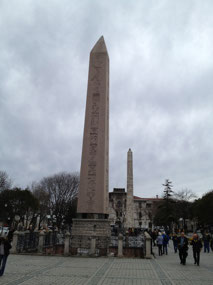
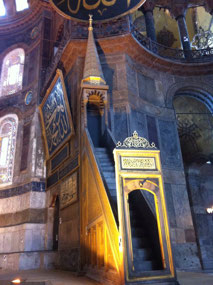
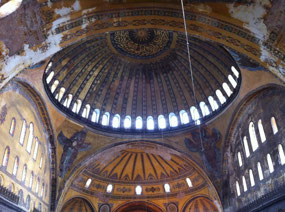
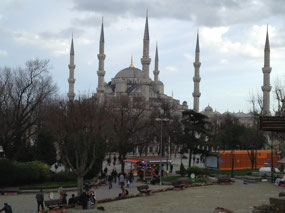
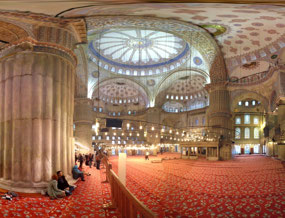
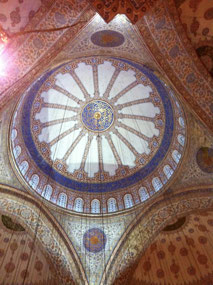
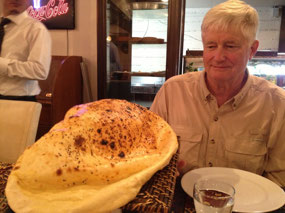


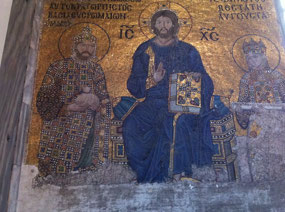
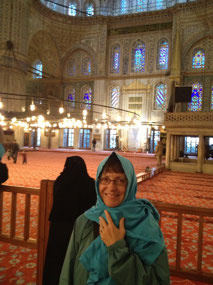
2025-05-23